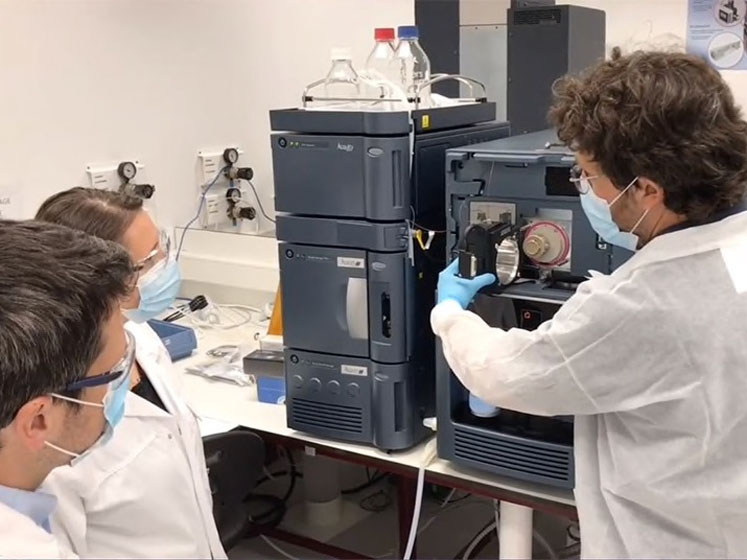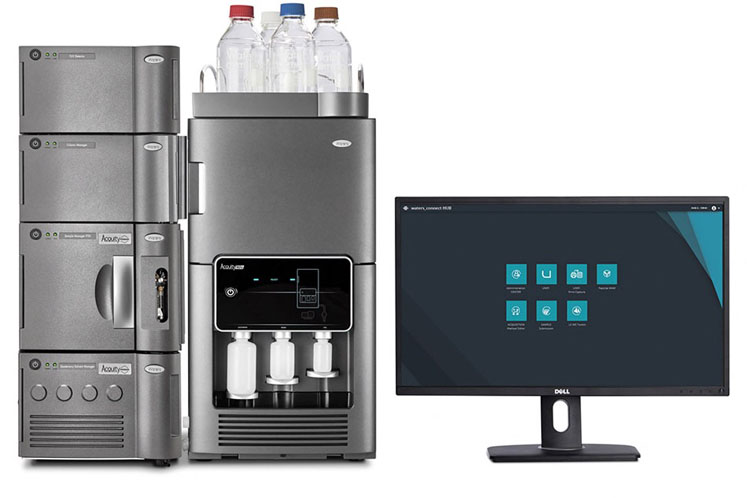Those are some quite big questions to answer, says Magnus, but when it comes to manufacturing biologics, the key point is that we’re working with living cells. Traditionally, the focus has been on synthesised chemicals and/or small drugs that were relatively easy to produce; with bioprocessing, we work with live organisms that have been engineered to express a certain molecule.
Not only must that be the right molecule but, if you compare a synthetic drug to, say, a single piece of LEGO – a building block — then the biologic is essentially a combination of thousands of LEGO elements. Not only that, the biologic can carry modifications, so there are a lot of complicating factors to consider. And you have to get the soup — the cell culture — right because without the correct conditions, the expression system won’t work as planned.
So, first it’s important to express the molecule of interest (a monoclonal antibody, for example), at a high yield level and in a safe way, and then purify it. There are a number of internal and external influences — or twists and turns as Magnus describes them — that can affect the manufacturing process.
In essence, the size of the molecule, the way the process modifies it, the removal of impurities and then making it stable and safely available to patients are the main hurdles that need to be overcome.
Taking a step back from the role of the process engineer, Nick comments on what pharmaceutical companies as commercial entities are trying to achieve. They want to create products and get them to market as quickly as possible. Staying ahead of the competition means a longer period of exclusivity, which is critical in today’s market, but it also brings cost benefits.

Manufacturing biologics is expensive and we hear about some of the eye-watering prices associated with advanced therapies, but that’s because producing these drugs is incredibly complex. Speed to market is therefore paramount both in terms of return on investment and making the drugs more affordable to patients.
Despite any altruistic aspirations, however, safety is non-negotiable; any breach in the duty of care or a compromise in standards and the product is unacceptable. Again, we’ve read media reports and seen the bad press, which can be devastating to an organisation. So, although being able to do things quicker and cheaper is ideal, quality is always the top priority.
Magnus entirely agrees and also notes that, compared with the blockbusters of the past, companies are less inclined to invest in large-scale purpose-built facilities. We don’t really see that type of production anymore. Now, it's more modular, he adds, so you can adapt and change your process depending on, for instance, the need to react to a pandemic outbreak. It’s important to have the flexibility to be able to produce different modalities within the same plant.

Compared with 20–30 years ago, today’s product pipeline is incredibly diverse; there are monoclonal antibodies, subunits, bi- and trispecifics, fragments and mRNA-based moieties, to name a few. So you have to be able to handle a variety of products and also, maybe, run different campaigns in one facility. As Nick mentioned, this is when both speed and agility are vital if you want to push more products through the manufacturing pipeline.
People and procurement
Another issue that the industry is struggling with is finding skilled personnel. It’s a shame that chemistry has lost its appeal, particularly because the need for trained staff is increasing. Yes, notes Magnus, automation can play a role and eliminate certain manual handling steps, but you still need qualified people and the concept of the fully automated lab is a long way off.1
Furthermore, the entire industry is still in the grips of a significant supply chain issue. More specifically, explains Magnus, what companies want to do is ensure security of supply; regional sourcing is no longer 100% reliable, which means you have to identify a second or third supplier from a different geography.
You can't depend on a single provider. If we look at what’s happening in the world today; whether that’s a pandemic, conflict, etc., rethinking how you operate your bioprocessing line and secure your supplies is extremely important.
Even now, I’m not sure we’re back up to speed in terms of securing supplies of components or bioreactor bags, for example. Post-COVID waiting lists are very long and supply shortages can shut down basic chemical production and/or bioproduction.
Add to that the need to work with sustainable solutions and we’re dealing with a couple of the most critical security of supply pain points. And I’m not just talking about receiving goods, pharmaceutical companies have to be able to deliver the drugs they make.
Having to stop the production of biologic drugs and be unable to supply them to patients would have a massive impact on an organisation’s bottom line and reputation — which would be the worst-case result of not being able to source raw materials.

Sure, you can look to reduce the amount you consume, limit the volume of buffers used, etc., and intensify your bioprocessing, such as looking at water as a resource in a new way, but there are certain constraints and shortcuts that can’t be taken.
Adding to the conversation, Nick says: in terms of cost and time savings, as well as consumables, one of things you can do if you have an iterative process, is to reduce the number of trial-and-error steps or stages to make yourself less dependent on the consistent supply of those items. Of course, it’s something that people are looking at … as long as it doesn't affect the safety of the finished product.
Waters Corporation is in a really good position here because, owing to the strength of our supply chain, companies are keen to partner with us. We’re a large organisation with global manufacturing and distribution capabilities. It’s of great value to suppliers who produce — and need to be able to release — filed products that require specific consumables.
Once you have a filed process, changing any aspect is a huge logistical and administrative challenge; people want to avoid that as much as possible. So, both for the short- and long-term, we’re very much focused on eliminating any vulnerability in the supply as well as keep our customers — and us — in business.
Digital contributions
Touching on one of the industry’s other megatrends, the discussion turns to the use of artificial intelligence (AI) and virtual reality to augment process optimisation. Can the likes of machine learning etc. help to make iterative processes shorter, more effective and, at the same time, safe and compliant?
Nick states that the idea of process optimisation is really close to the heart of what Waters is working on at the moment. Not necessarily AI, per se, he continues, but in terms of being able to make informed decisions and automating those processes as well.
If you think about the way a biologic is developed, process intensification is key; we’re looking at how to feed a reactor so that the living cells inside can create the required product at the right yield and quality.
There’s a huge list of parameters that are going to affect that and even small changes in, say, pH or temperature have a massive impact on what comes out the other end. As such, analytical testing with LC-MS, for example, is absolutely critical to understanding those product attributes, such as purity and identifying variants.

Historically, however, that kind of technology has been quite time-consuming, complex and, often, an offline process. Culturing a standard batch of a mAb might take 2 weeks; whereas receiving the analytical test data from a centralised analytical laboratory for that batch can take up to 6–8 weeks.
Now, if you're trying to inform a process that takes 2 weeks and it takes 8 weeks to get a result, that’s a huge bottleneck! No one can wait a month before deciding how to proceed with the next process development experiment. They’re going to work with the available information, which will be quite limited.
So, the idea behind our BioAccord™ system, for example, is that it’s a high performing LC-MS system, but is also straightforward and simple to use. It's designed for people who aren’t mass spectrometry experts and still delivers valuable and accurate information.
Put that next to a bioreactor and, all of a sudden, a process engineer is not wasting days or weeks waiting for a result. It enables them to make near real-time operational decisions while the process is actually running … as opposed to once it’s finished.2
Being able to make informed decisions is critical, adds Magnus, and we believe this system — which is a step towards both process analytical technology (PAT) and quality by design (QbD) — helps with cost management and process development. Getting the processing parameters right at an early stage is important because, once you start commercial-scale production, you really don’t want to have to make alterations or changes.
The PAT tools that we're working on are designed to provide more data, the flexibility to look at different modalities or component analytics and connect with integrated workflows. We’re not able to provide, for example, an inline MS solution that delivers instant feedback, but we are working towards an online tool that takes data from an MS and turns that information around very quickly.
This would translate into faster process development, better controlled manufacturing environments and, perhaps relating that to AI, the integration of informatics platforms. Those are the solutions that Waters offers by going beyond data acquisition with simple detectors.
At-line/online process monitoring can also be used as a quality control tool, notes Magnus; once you've optimised your parameters, you want to minimise fluctuations.
Real-time data collection certainly helps you to do that; preventing deviations means that you can confidently release a safe end product for patient use, which is always the ultimate goal. The risk of potentially releasing a biologic that you don't fully understand because you haven't done the prerequisite testing could equate to millions of dollars of lost revenue that would, quite literally, go down the drain.
There are also environmental aspects to consider, Nick adds; efficient processes mean less waste, lower energy and raw material costs. Shorter hold-up times and the ability to work more quickly all contribute to a more sustainable operation … all the while keeping safety in mind.
Technologies such as mass spectrometry (MS) provide the additional data that give you more confidence in the quality of the product you’re working with, which gives you another level of security.
Looking ahead
We’re not expecting to replace every sensor in a bioreactor with MS, but I don’t see many other technologies that offer the same level of performance or functionality and that complement existing solutions in terms of Design of Experiments and impacting product attributes. And that only comes with process understanding.
At Waters, we’re an LC-MS analytics solution provider; but, to improve our service offering, we’ve been working on a couple of developments that I think are worth mentioning, adds Nick. We’ve partnered with Sartorius, for example, which is yielding a lot of exciting data and potential cloud-based solutions.3
We’ve also recently opened the second of our Immerse laboratories, this time in Newark (Delaware, US), which is focused on advancing industrial processes to make and characterise biotherapeutics.4
Drawing the conversation to a close, Nick and Magnus comment on the key drivers behind the development and implementation of these kinds of technologies. Initiatives have been in place for some time, says Magnus, but the COVID pandemic highlighted that something needed to be done.
As such, the regulatory authorities and the biopharmaceutical industry came together to expedite the efficient production of safe vaccines. It demonstrated that things could be done quicker and the effects of the last few years are still playing out.
It’s an exciting time, though, and the upshot will certainly be process intensification, automation and the increased implementation of mass spectrometry; with all the new modalities, flexibility will be key.
Manufacturers may need to adapt and respond more quickly to external factors in the future, particularly regarding security of supply. Where next? I wish I had a crystal ball, adds Magnus, but I understand there’s increasing regulatory/ pressure to minimise animal testing, which will fundamentally affect the development and approval of drugs and so on.
We’re just starting to explore a vast ocean of possibilities in which modularity, agility and digitalisation will play important roles. For personalised medicines, for instance, we’ll need miniaturised production facilities for individual patients, and it’s exciting to see these innovative technologies emerging.
I think we might also see more applications for extant modalities such as nucleic acids and mRNA therapies, which are progressing at pace. That diversity in the biopharmaceutical pipeline will necessitate the increased utilisation of robust and reliable analytics; and, as a company, I believe that Waters is very well placed to meet those demands.
References
- https://manufacturingchemist.com/news/article_page/Humans_hybrid_models_and_the_power_of_collaboration_part_I/176621.
- https://www.waters.com/waters/en_GB/Upstream-Bioprocess-Development/nav.htm?cid=135095468.
- www.waters.com/nextgen/gb/en/c/announcement/sartorius.html.
- https://ir.waters.com/newsroom/press-release-details/2022/Waters-and-University-of-Delaware-Announce-Official-Opening-of-Immerse-Delaware-Lab/default.aspx.




